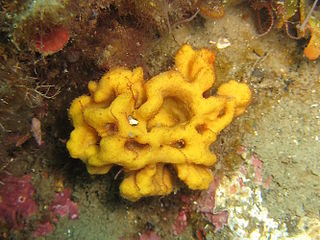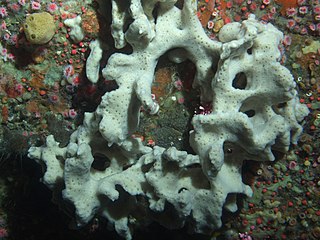
Geodia is a genus of sea sponge belonging to the family Geodiidae. It is the type genus of its taxonomic family.

Halichondria is a genus of sea sponges belonging to the family Halichondriidae. These are massive, amorphous sponges with clearly separated inner and outer skeletons consisting of bundles of spicules arranged in a seemingly random pattern.

Plakinidae is a family of marine sponges. It is composed of seven genera:

Axinella is a genus of sponges in the family Axinellidae first described in 1862 by Eduard Oscar Schmidt. Species of Axinella occur in the Indian and Pacific Oceans. Most of these sponges are smaller than 20 cm, and have a yellow or orange colour.
Stelletta is a genus of sea sponges belonging to the family Ancorinidae.

Clathria is a large genus of demosponges in the family Microcionidae.

Haliclona is a genus of demosponges in the family Chalinidae.

Ircinia is a genus of sea sponges in the family Irciniidae.
Dictyodendrillidae is a family of sponges in the order Dendroceratida.

Ancorinidae is a family of marine sponges belonging to the order of Tetractinellida.
Discodermia dissoluta is a deep-water sea sponge found in the Eastern, Southern, and Southwestern Caribbean, and in the Greater Antilles.
Calthropella is a genus of sea sponges in the order Tetractinellida. It is the only genus in the monotypic family Calthropellidae.

Craniella is a genus of marine sponges in the family Tetillidae.

Clathria (Clathria) is a subgenus of demosponge in the family Microcionidae.
Esperiopsis is a genus of demosponges, comprising around 30 species found in oceans around the world.

Mycale is a genus of demosponge with 240 recognised species in 11 subgenera. It has been a large genus with multiple subdivisions since it was first described in 1867.
Amorphinopsis is a genus of sea sponges belonging to the family Halichondriidae.
Ciocalypta is a genus of sea sponges belonging to the family Halichondriidae.

Phorbas is a genus of demosponges belonging to the family Hymedesmiidae.

Latrunculia is a genus of demosponges. It is well known for the diverse array of chemical compounds found in its species, including the latrunculins, which are named after this genus. Many of these are medically important, including anti-cancer compounds such as discorhabdins.













